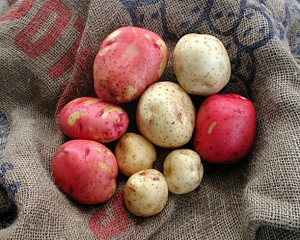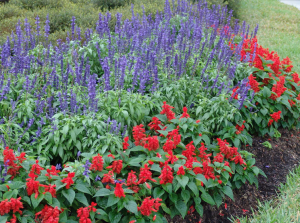
by Ray Bodrey | Feb 17, 2022
Are you “chomping at the bit” to get started gardening this year, but not sure what you can do at this point? Well, good news, there’s plenty of things that can be done whether landscaping or vegetable gardening is your passion.

“New” potatoes grown in Florida. Photo Credit: C. Hutchinson, UF/IFAS
Temperatures can drop significantly in the Panhandle this month, and with short notice. If you want to enhance your flower beds, be sure to use annual bedding plants that can withstand the chill. Dianthus, pansy, viola and dusty miller are some good suggestions to plant. It’s a good time to plant bulbs too. Dahlias, crinum and agapanthus are good choices this time of year. Be sure to provide adequate mulch and water during this cold weather month. There are plenty of trees and shrubs that are beginning to bloom this time of year also. If you’re like me, your allergies will tell you this too. Red maple and star magnolia, just to name a couple, will soon be in bloom.
As for vegetable gardening, the potato is a good choice for Florida gardens. As Americans, we consume approximately 125 pounds per person a year. Potato farming is done commercially in Florida, but mostly with “new” potatoes. These are the small, rounded immature potatoes that have a thin skin and are perfect for low country boils.
It’s February, so it’s Irish potato planting season. The planting season for this cultivar for the Panhandle is from February 1st to mid-March. Sweet potatoes can be planted beginning in late March through June. A hundred pounds of seed potatoes should yield approximately ten bushels. Buy healthy certified seed potatoes from a garden center. Avoid using table stock potatoes. Often, table stock will not sprout successfully. Store bought potatoes are often treated with sprout inhibitors too. This treatment can cause development issues if used as seed potatoes.
Raised beds, at least 6”, are the best way to grow potatoes. Be sure to fertilize the bed soil mixture and fertilize again down furrows when planting. Irish potatoes require copious amounts of fertilizer. For fertilizer, use a general, complete formulation like 10-10-10. Before planting, be sure to dust the seed potatoes with a fungicide to reduce the chance of decay. Plant seed potatoes 3” in depth, at 12” apart and allow for 36” row spacing.
Please take these gardening tips into consideration this month and the next. Spring is just around the corner. Happy gardening! For more information please contact your local county extension office.
Supporting information for this article can be found in the UF/IFAS EDIS Publications, “ Florida Vegetable Gardening Guide” by Sydney Park Brown, Danielle Treadwell, J. M. Stephens, and Susan Webb : http://edis.ifas.ufl.edu/pdffiles/VH/VH02100.pdf and “Growing Potatoes in the Florida Home Garden”, by Christian T. Christensen, Joel Reyes-Cabrera, Libby R. Rens, Jeffrey E. Pack, Lincoln Zotarelli,Chad Hutchinson, Wendy J. Dahl, Doug Gergela, and James M. White: http://edis.ifas.ufl.edu/pdffiles/HS/HS18300.pdf
Supporting information can also be found on the UF/IFAS website under “Florida Gardening Calendar” by Sydney Park Brown: http://solutionsforyourlife.ufl.edu/lawn_and_garden/calendar/pdfs/February_North.pdf

by Ray Bodrey | Feb 10, 2017
Yes, even with cool weather setting in, much can be done on the flower gardening front. Let’s kickoff 2017 by being the envy of the neighborhood with flower beds that are rich and vibrant in color.

Figure 1: Bedding Annuals.
Credit: Sydney Park Brown, UF/IFAS.
Annual bedding plants are plentiful in variety and come in an array of colors and forms. These plants will highlight home landscapes, whether in beds or in containers on porches, decks and patios.
Annuals are divided into two categories, warm and cold season. Warm season are tender, and damaged by the first frost. Cool season on the other hand, cannot withstand heat or excessive rainfall. Therefore, to be successful with annuals, you must plant at the right time. For this region, late March for the earliest warm season annual planting and late fall for the earliest cool season annual planting is ideal. For the Panhandle, most annuals only live through the season, not the year. For this time of year, some examples of annuals that enjoy cooler temperatures are the pansy, viola, petunia and snapdragon.
When shopping for annuals, pay close attention to how much sunlight the variety will tolerate. This should be displayed on the container. Be sure to plant your annuals under a minimum of partial light. No annual can tolerate heavy shade. Remember when deciding on which variety to purchase, that annuals are an accent piece or supplement to the landscape, and not the focal point. Think of harmony and balance among other plants in your landscape before coming to a decision.

Figure 2: Pot-in-Pot Method.
Credit: Sydney Park Brown, UF/IFAS.
As for care, be sure to water annuals after planting. Provide water on a routine basis until the root system has established. The best way to achieve this is making sure the topsoil layer stays moist early on.
Some gardeners prefer the “pot-in-pot” method with annuals. This method consists of sinking empty pots into the soil and then dropping potted annuals of the same size pot, into the empty pots. This works well for our area for two reasons. Often, our native soils, especially if you live closer to the coast, are not conducive to annual flower bed gardening. By using the pot-in-pot method, rich potted soil encompasses the annual throughout its life span and with no soil bed amendments needed. Also, this can make an otherwise long, laborious gardening day become very short regarding the change out planting from cold to warm season annuals and vice versa.
When supplying water to annuals, be careful with high pressure overhead watering systems, as this can damage petals and can cause bloom rot. A drip irrigation system or handheld hose watering is the best method. Fertilize annuals with a controlled release nitrogen fertilizer, so that a steady supply of nutrients is provided throughout the season. For weed control, mulching with use of pre-emergent herbicides is the best course of action. Depending on the size of landscape, hand weeding maybe the best practice. For pest management use a spot treatment insecticide for the entire flower bed once an insect infestation or disease problems emerge.
The information provided in this article will help your annual bedding plant efforts and in turn reward you with a beautiful flower landscape throughout the year. For more information on annual flower bedding plants, please contact your local county extension office.
Supporting information for this article can be found at the UF/IFAS EDIS Publication, “Gardening with Annuals in Florida” by Dr. Sydney Park Brown: http://edis.ifas.ufl.edu/mg319
UF/IFAS Extension, An Equal Opportunity Institution.





